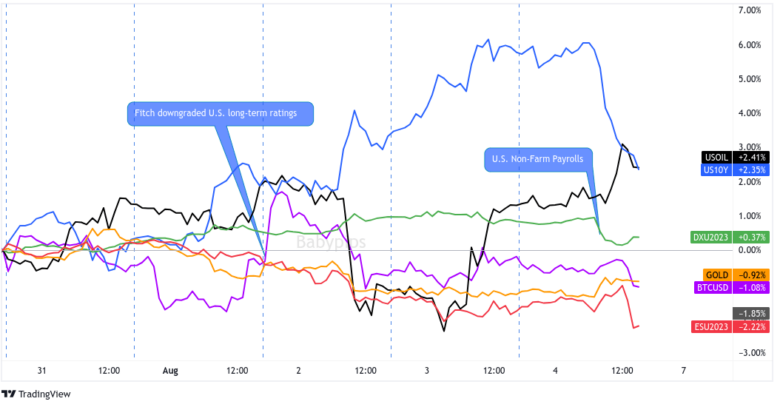Just when we thought that a brand spankin’ new trading month would bring more asset-buying, high interest rate and global growth jitters dragged “risky” assets lower this week.
That also meant that safe havens like USD and JPY dominated against their counterparts.
So, what exactly happened? I can explain, but lemme show you the biggest headlines first:
Notable News & Economic Updates:
? Broad Market Risk-on Arguments
China’s official manufacturing PMI improved from 49.0 to 49.3 in July, while the services PMI dropped from 53.2 to 51.5 on lower construction activity
China Caixin services PMI improved from 53.9 to 54.1 in July, marking the seventh consecutive month in expansion territory
Euro Area Flash Consumer Prices for July: 5.3% y/y (5.2% y/y forecast; 5.5% y/y previous); Core CPI came inline with June at 5.5% y/y (5.4% y/y forecast)
Germany’s unemployment rate unexpectedly fell from 5.7% to 5.6% in July, with the number of people out of work decreasing by a net of 4,000 despite the companies’ demand for labour remaining “strained.”
ANZ’s business outlook survey showed that a net of 13.1% of respondents expected the New Zealand economy to get worse in July, an improvement of 5 points from June
Japan’s retail sales grew by 5.9% y/y in June (vs. 5.4% expected, 5.8% in May); monthly retail trade is down by 0.4% (vs. 0.2% expected, 1.4% gain in May)
Japan’s unemployment rate edged lower from 2.6% to 2.5% in June, the lowest since January
On Friday, Chinese state authorities stated that small firms and investors face difficulties but that the economy will improve in H2
U.S. Non-Farm Payrolls for July: 187.0k (190.0k forecast; 185.0k previous); Unemployment rate dipped to 3.5% (3.6% forecast/previous)
? Broad Market Risk-off Arguments
Fed’s bank lending survey showed U.S. banks reporting tighter credit, weaker loan demand in Q2 2023
Credit rating agency Fitch downgraded U.S. long-term credit grade from AAA to AA+, citing “Expected fiscal deterioration over the next three years, a high and growing general government debt burden, and the erosion of governance relative to ‘AA’ and ‘AAA-rated peers over the last two decades.”
U.S. weekly jobless claims rose by 6k w/w to 227k; continuing claims rose by 21k to 1.7M; productivity rose 3.7% q/q in Q2 vs. -2.1% in Q1; unit labor costs rose by 1.6% q/q vs. 4.2% q/q/ previous
China Caixin manufacturing PMI slips into contraction, down from 50.5 to 49.2 in July, as both supply and demand weakened
HCOB Eurozone Services PMI Business Activity Index for July: 50.9 vs. 52.0 previous; “the overall rate of input cost inflation fell further beneath its long-run average”; Employment growth was sustained despite falling slowing business activity
On Thursday, the Bank of England raised its key interest rate by 25 bps as expected to 5.25%; warned that interest rates will likely stay high for some time.
S&P Global / CIPS UK Services PMI for July: 51.5 vs. 53.7; “another strong rise in average cost burdens was reported by service sector companies during July”
On Tuesday, RBA kept its rates unchanged at 4.10%. In its statement, RBA shared that “Some further tightening of monetary policy may be required” but will “depend upon the data.”
RBA Statement on Monetary Policy highlighted a slowdown in inflationary pressures during the June quarter but says rates may need to go higher
New Zealand’s unemployment rate ticked up from 3.4% to 3.6% in Q2 2023- a two-year high – as strong labour demand was met with more people looking for work
On Monday, BOJ reportedly bought about 300B JPY (2B USD) worth of bonds in an unscheduled operation after Japanese bond yields temporarily surged to 0.605%, the highest since June 2014
BOJ launched a second unscheduled bond-buying operation on Thursday, and said it would buy 400B JPY ($2.8B) worth of securities after the 10-year note hit a fresh nine-year high of 0.65%
Global Market Weekly Recap

Dollar, Gold, S&P 500, Oil, U.S. 10-yr Yield, Bitcoin Overlay Chart by TV
The week started on a net positive note after word got around that China’s government would roll out stimulus measures that could target car, housing, and smart home appliances and electronics consumption. No deets yet, but the prospect of such policy was enough to lift risk sentiment in some key Asian assets.
The Bank of Japan (BOJ) was doing a different kind of lifting as it unexpectedly bought about 300B JPY ($2B) worth of bonds after the benchmark government bond yields briefly hit 0.605%–that’s the highest yield since June 2014!
For newbies out there, higher bond yields could attract investors into buying government bonds. This may then pull the spotlight away from “riskier” assets that may better stimulate inflation.
Optimism in the European and U.S. session came from relatively strong economic and earnings that supported soft landing speculation for the U.S. and maybe other major economies.
“Risky” assets like crude oil and commodity-related currencies gained ground while safe havens like USD, JPY, and CHF lost pips. All the USD-selling likely helped spot gold, however, signaled by its rally during the European and U.S. sessions to hit its intraweek highs near $1,970.
The tides started turning against risk-takers on Tuesday when August (the month, not the Taylor Swift song) started.
For starters, China’s manufacturing PMI survey slipped into contraction sentiment in July as both supply and demand weakened. The Reserve Bank of Australia (RBA) also kept its interest rates at 4.10%, disappointing those who had priced in another rate hike.
And then there were market players who did a bombastic side eye at some overvalued assets. U.S. equities took a breather from its 2023 rally while the U.S. 10-year yields broke above 4.00%.
Higher U.S. yields and risk aversion translated to higher USD demand across the board. BTC/USD also dropped to just under $29,000 and spot gold extended its downswing from its $1,970 highs.
All that before Fitch even dropped a bomb on the markets!
Just after the U.S. markets closed, the credit rating agency downgraded U.S. long-term credit grade from AAA to AA+ over the economy’s growing debt and an “erosion of governance” relative to its peers. Ouch!
Not surprisingly, Asian equities suffered on Wednesday from the one-two punch of weak Wall Street session and Fitch’s downgrade. European and U.S. equities saw similar trends later that day. The comdolls also traded lower while safe havens like JPY traded higher.
The dollar, in particular, extended its bullish run as the downgrade bumped up the 10Y and 30Y yields even higher. It also didn’t hurt the safe haven’s upswings that a hot ADP report later that day supported a “higher for longer” stance from the Fed and fueled global growth fears.
Interestingly, BTC/USD acted like a safe haven and hit an intraweek high near the big $30,000 while spot gold made new intraweek lows. Oh, and U.S. crude oil prices dropped despite EIA reporting a record weekly drawdown of oil inventories.
Make it make sense, people!
Thursday was a bit more chill (read: more of the same) as traders stepped onto the sidelines ahead of the U.S. NFP report.
The BOJ didn’t get the memo as it made off schedule moves for a second time this week, this time buying about 400B JPY ($2.8B) worth of assets to keep yields down after the benchmark 10Y yield hit a new nine-year high of 0.650%.
The Bank of England (BOE) also made some waves when it raised its interest rates by 25bps to 5.25% as expected. The “hawkish hike” initially weighed on GBP but the prospect of “higher for longer” BOE rates eventually pulled GBP from its intraweek lows.
On Friday, we got hit with the monthly monster U.S. Non-Farm Payroll jobs report, this time showing a smaller-than-expected net jobs gain but a tick lower in the unemployment rate. Average hourly earnings came in above expectations at 4.4% but remained inline with June’s growth rate.
Arguably, this month’s U.S. jobs update wasn’t really enough to definitively sway the Fed rate hike debate for September, but it seems like it was enough to spark sweet volatility for traders.
The market sold Greenbacks right off the release, up until the London close where USD was able to find a small bid and take back some of its losses and maintain total dominance against the majors into the weekend.









